Automated Container Terminal in Taiwan
November 26, 2019
Thanks to its advantageous geographical location, the port of Kaohsiung has grown as a transship container port between the west coast of North America and South East Asia. Amongst the seven international ports of Taiwan, i.e., Kaohsiung, Keelung, Taichung, Hualien, Taipei, Suao and Anping, the port of Kaohsiung is the largest container port in Taiwan. It handles around two thirds of all container throughput of all Taiwan as the gateway for import and export of Taiwan and also as a key hub in the Asia- Pacific region. It ranked 15th in the Lloyd's List One Hundred Ports in 2018, whereas the highest of Japanese ports was Tokyo with 35th position in the ranking. In 2018, the throughput of the Port of Kaohsiung was 10,445,726 TEU, which is more than twice as much as that of Tokyo.
Due to intensive competition with other ports in the region, however, especially fast-growing Chinese ports, the port of Kaohsiung is striving to increase its efficiency by automating the container handling operations, such as adoption of Automated Rail-Mounted Gantry Cranes (ARMGs) and location system for trucker chassis utilising Radio Frequency Identification (RFID) technology.
Location of Seven International Ports of Taiwan
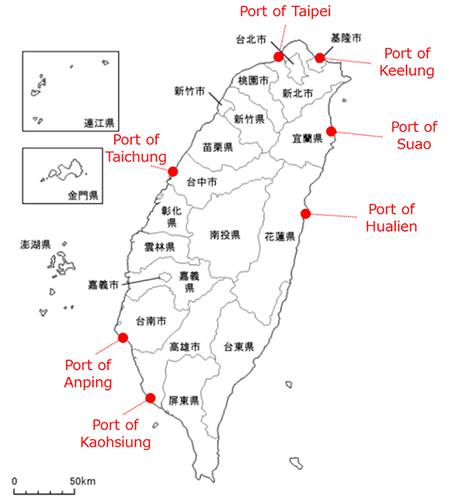
World Top 20 Container Port Ranking in 2018
| Ranking | Port | Country/Region | Annual Throughput (TEU) |
|---|---|---|---|
| 1 | Shanghai | China | 42,010,200 |
| 2 | Singapore | Singapore | 36,599,300 |
| 3 | Ningbo-Zhoushan | China | 26,351,000 |
| 4 | Shenzhen | China | 25,740,000 |
| 5 | Guangzhou | China | 21,922,100 |
| 6 | Busan | South Korea | 21,663,000 |
| 7 | Hong Kong | China | 19,596,000 |
| 8 | Qingdao | China | 19,315,400 |
| 9 | Tianjin | China | 15,972,000 |
| 10 | Dubai | United Arab Emirates | 14,954,000 |
| 11 | Rotterdam | The Netherlands | 14,512,661 |
| 12 | Port Klang | Malaysia | 12,316,003 |
| 13 | Antwerp | Belgium | 11,100,000 |
| 14 | Xiamen | China | 10,702,300 |
| 15 | Kaohsiung | Taiwan | 10,445,726 |
| 16 | Dalian | China | 9,770,000 |
| 17 | Los Angeles | United States | 9,458,749 |
| 18 | Tangung Pelepas | Malaysia | 8,960,900 |
| 19 | Hamburg | Germany | 8,730,000 |
| 20 | Long Beach | United States | 8,091,023 |
| (Omission) | |||
| 35 | Tokyo | Japan | 4,570,000 |
Source:Lloyd's List:One Hundred Ports 2019
Kao Ming Container Terminal (KMCT) in Kaohsiung is operated by Kao Ming Container Terminal Corp., which was established by Yang Ming Marine Transport Corp. as a Build-Operate-Transfer (BOT) project under the Port of Kaohsiung Intercontinental Container Terminal Project. KMCT is located in the 6th Container Terminal, adjacent to the second port entrance and operates four container berths, i.e., No. 108-111, with a total length of 1,500 meters and with a draft of 16.5 meters, that can accommodate four 10,000-TEU and 14,000 TEU plus vessels.
Terminal Layout of the Port of Kaohsiung
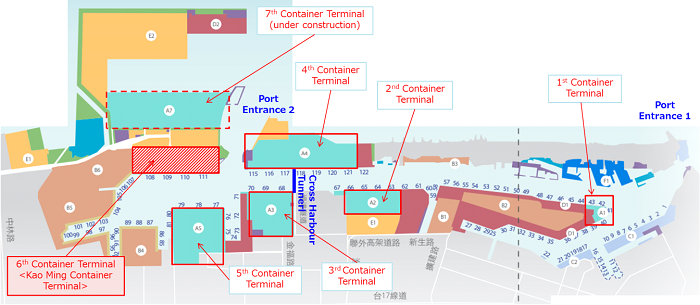
Source:Taiwan Free Trade Zone website
Being the first automated container terminal in Taiwan, KMCT has over 30 Automated Rail-Mounted Gantry Cranes (ARMGs) which are remotely operated. Although container loading and unloading to/from vessels is still operated by manned gantry cranes with operators actually sitting inside them, ARMG operators stay in the comfortable control room inside the terminal building to remotely load and unload containers in the container yard. According to our interview with KMCT last year, one ARMG operator usually operates four to six ARMGs, thus manpower reduction as well as work efficiency has dramatically improved compared to one-operator with one-RMG operation. This is because container handling above nine meters high is automated. ARMG operator can switch to operate another ARMG after making sure containers are picked up or dropped off properly only up to nine meters high. 95% of container handling is already automated in KMCT.
In addition, KMCT utilises Radio Frequency Identification (RFID) technology to adopt location system for trucker chassis. For example, when a trucker arrives at the terminal to pick up a container, their document is read by Optical Character Recognition (OCR) system and a location slip for their container and an RFID card are issued. Then the driver goes to the lane specified by the location slip and scans the RFID card onto RFID reader located at the lane. Their container will be at the location by the time the truck arrives there. The container is automatically handled up to nine-meter high and then an ARMG operator operates the container remotely to load onto the truck below nine meters. Remote operators confirm the four corners of containers stay in the right position of the truck chassis by indicating drivers. After picking up their container, the driver returns the RFID card at the gate before leaving the terminal. According to the interview, it takes 11 minutes on average for truckers between entering and leaving the terminal.
Automated Operations in the Kao Ming Container Terminal(KMCT)
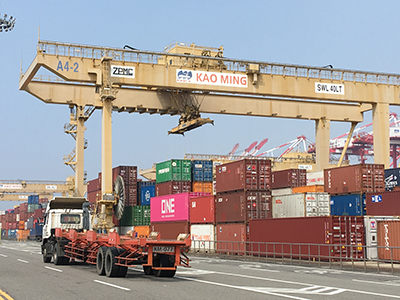
(Container yard of KMCT)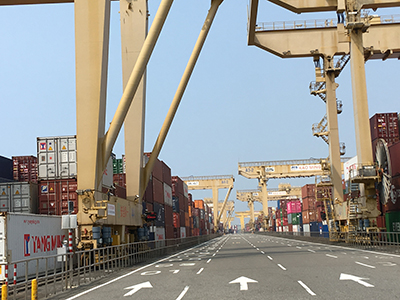
(Container yard of KMCT)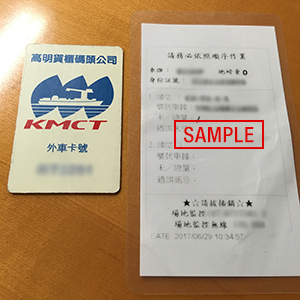
(RFID card and location slip)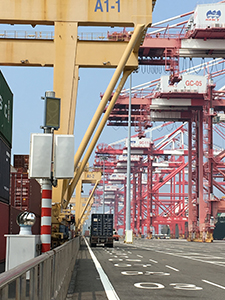
(RFID reader)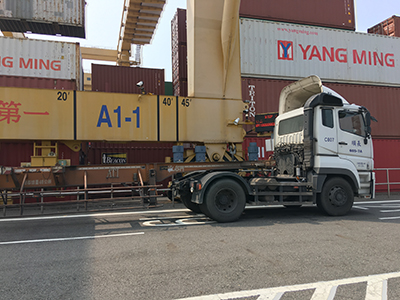
(Reading a RFID card)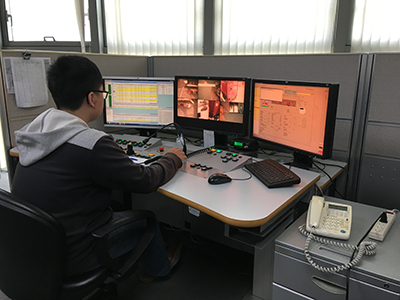
(Control room (remote operation))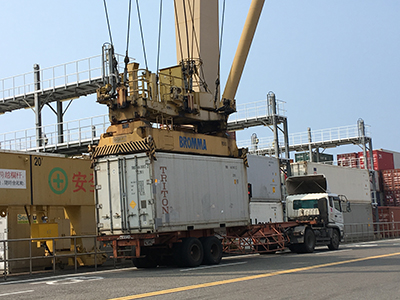
(Container drop (remote operation))
Source:Nittsu Research Institute and Consulting, Inc.
Aside from KMCT, the 7th Container Terminal of the port of Kaohsiung is being constructed as a part of the 2nd phase of the Intercontinental Container Terminal Project. Last year, Evergreen Maritime Corporation signed a lease contract with Taiwan International Ports Corporation, Ltd. (TIPC), a port operation and management company owned by the Ministry of Transportation and Communications, for the operation of the five container berths and will commence operations at the 7th container terminal in 2023. The new container terminal has a total length of 2,415 meters with a draft of 18 meters, which can accommodate 22,000-TEU vessels. Evergreen and TIPC says they will jointly develop an extensive, automated yard facility capable of handling at least 4.1 million TEU per annum. With this expansion and automation of handling operations, the port of Kaohsiung will tune to strengthen its competitiveness and sustain its status as a hub port in the Asia- Pacific region.
Source:
■Kao Ming Container Terminal Corp.
http://www.kmct.com.tw/en/index.php